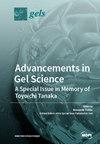Coenzyme-A-Responsive Nanogel-Coated Electrochemical Sensor for Osteoarthritis-Detection-Based Genetic Models
IF 5
3区 化学
Q1 POLYMER SCIENCE
引用次数: 0
Abstract
An electrochemical sensor sensitive to coenzyme A (CoA) was designed using a CoA-responsive polyallylamine–manganese oxide–polymer dot nanogel coated on the electrode surface to detect various genetic models of osteoarthritis (OA). The CoA-responsive nanogel sensor responded to the abundance of CoA in OA, causing the breakage of MnO2 in the nanogel, thereby changing the electroconductivity and fluorescence of the sensor. The CoA-responsive nanogel sensor was capable of detecting CoA depending on the treatment time and distinguishing the response towards different OA genetic models that contained different levels of CoA (wild type/WT, NudT7 knockout/N7KO, and Acot12 knockout/A12KO). The WT, N7KO, and A12KO had distinct resistances, which further increased as the incubation time were changed from 12 h (R12h = 2.11, 2.40, and 2.68 MΩ, respectively) to 24 h (R24h = 2.27, 2.59, and 2.92 MΩ, respectively) compared to the sensor without treatment (Rcontrol = 1.63 MΩ). To simplify its application, the nanogel sensor was combined with a wireless monitoring device to allow the sensing data to be directly transmitted to a smartphone. Furthermore, OA-indicated anabolic (Acan) and catabolic (Adamts5) factor transcription levels in chondrocytes provided evidence regarding CoA and nanogel interactions. Thus, this sensor offers potential usage in simple and sensitive OA diagnostics.用于骨关节炎检测的辅酶 A 反应性纳米凝胶涂层电化学传感器--基于基因模型
研究人员设计了一种对辅酶A(CoA)敏感的电化学传感器,利用涂覆在电极表面的CoA响应性聚烯丙基胺-氧化锰-聚合物点纳米凝胶来检测骨关节炎(OA)的各种遗传模型。CoA响应纳米凝胶传感器对OA中CoA的丰度做出响应,导致纳米凝胶中的MnO2断裂,从而改变传感器的电导率和荧光。CoA响应纳米凝胶传感器能根据处理时间检测CoA,并能区分对不同OA基因模型(野生型/WT、NudT7基因敲除/N7KO和Acot12基因敲除/A12KO)的响应,这些模型含有不同水平的CoA。与未经处理的传感器(Rcontrol = 1.63 MΩ)相比,WT、N7KO 和 A12KO 具有不同的抗性,随着培养时间从 12 小时(R12h = 2.11、2.40 和 2.68 MΩ)变为 24 小时(R24h = 2.27、2.59 和 2.92 MΩ),抗性进一步增加。为简化应用,纳米凝胶传感器与无线监测装置相结合,可将传感数据直接传输到智能手机上。此外,软骨细胞中OA指示的合成代谢(Acan)和分解代谢(Adamts5)因子转录水平为CoA和纳米凝胶的相互作用提供了证据。因此,这种传感器有望用于简单而灵敏的 OA 诊断。
本文章由计算机程序翻译,如有差异,请以英文原文为准。
求助全文
约1分钟内获得全文
求助全文

 求助内容:
求助内容: 应助结果提醒方式:
应助结果提醒方式:


